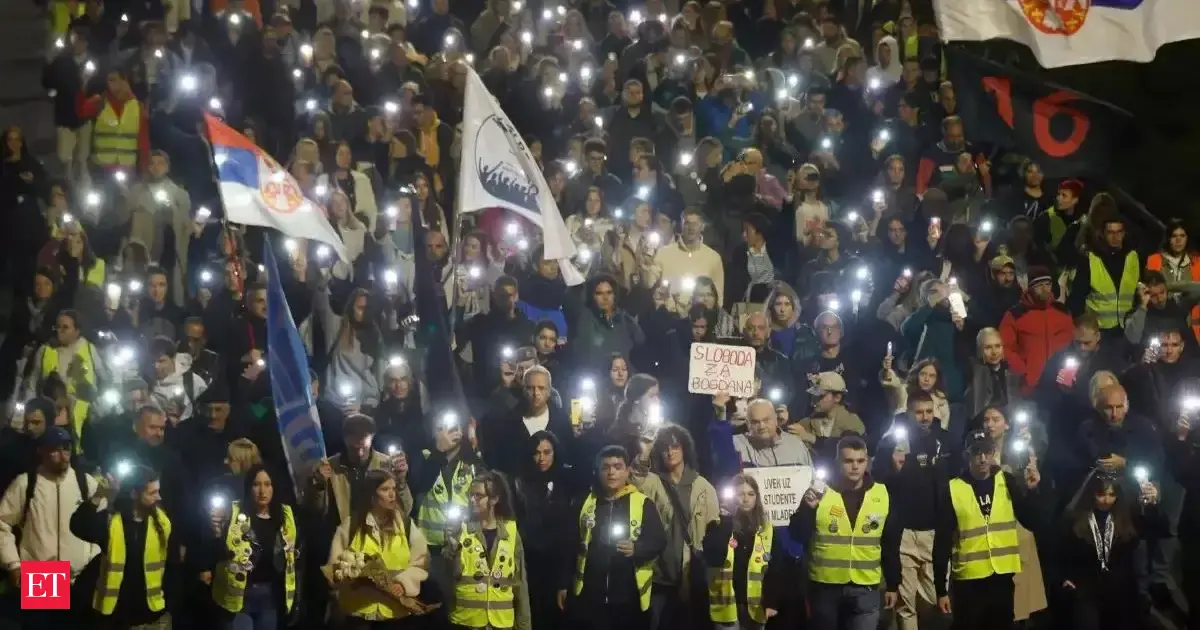By Zoran Djindjic
Copyright indiatimes

APProtests in Serbia
On October 5, 2000, mass protests in Belgrade ousted Slobodan Milosevic, Serbia’s nationalist strongman who spent more than a decade in office throughout bloody wars, crippling sanctions and financial collapse.The uprising, triggered by the president’s refusal to concede electoral defeat, brought dramatic change to a country that had suffered widespread destruction from NATO bombardment and economic decline.But 25 years on, many of Milosevic’s ministers have returned to power.Now they decry his overthrow as they face some of the largest demonstrations in the Balkan nation’s history.Here are the essential facts about the overthrow of Serbia’s strongman:Live EventsWhat happened?After ruling over a disintegrating Yugoslavia in the 1990s, Milosevic lost presidential elections in September 2000 to opposition leader Vojislav Kostunica.In a country still recovering from NATO bombing that had driven Serbian forces out of Kosovo at the end of the 1998-1999 war, his refusal to accept the result catalysed the opposition.Backed by unions, students and the pro-democratic opposition, protests soon spread nationwide.Strikes in late September at major coal mines brought much of the country to a standstill and set the stage for the October 5 march on Belgrade.From early morning, hundreds of thousands of people poured onto the streets of the capital. Some arrived on tractors and bulldozers as lines of traffic streamed into the city to attend the rally.The demonstrators surrounded the parliament, demanding that Milosevic step down.Despite being hit with tear gas and batons, the crowd eventually broke through lines of riot police and stormed parliament.Using a bulldozer, protesters also smashed their way into the offices of the rabidly pro-Milosevic state broadcaster and set it ablaze.As smoke billowed from the parliament building’s shattered windows, a growing number of police joined the protesters.Milosevic had clearly lost his grip on power, and unrest transformed into jubilant celebration.He would concede the next day.What followed?Kostunica, backed by the opposition coalition, was sworn in as the new president, and in the following months, Serbia elected its first democratic government led by Zoran Djindjic with overwhelming support in the ballot box.In June 2001, Milosevic was extradited to The Hague and accused of war crimes during the conflicts in Bosnia, Croatia and Kosovo. He died five years later before the trial reached a conclusion.But despite Milosevic’s extradition, many of his close associates remained in Serbia.Djindjic, who had pursued democratic reforms and prosecutions for those suspected of war crimes, was shot dead in 2003.He was assassinated by a special police unit tied to organised crime and the secret service.Kostunica remained in office until 2008, when Milosevic’s Socialist Party (SPS) returned to power as part of a coalition government. It has been part of every government since.Why does it matter now?Many who held power on October 5, 2000, have returned to office, while the parties that led the protests are once again in opposition.The Serbian Progressive Party, which emerged from the Milosevic-aligned Serbian Radical Party, has been in power since 2012.President Aleksandar Vucic, once Milosevic’s information minister, has again centralised power.The SPS has also returned under Ivica Dacic, a former Milosevic spokesman now serving as interior minister.Since November, anti-corruption protests have gripped the country as a push for a transparent investigation into a fatal railway station roof collapse morphed into a call for snap elections.Led by students, many born after Milosevic’s fall, the protests blame entrenched corruption for the tragedy that killed 16 people.Facing almost daily demonstrations, some drawing hundreds of thousands, Vucic and his ministers have labelled the backlash part of a foreign coup — echoing attacks on the popular movement decades ago.Vucic has insisted that a popular ousting, such as that of Milosevic in 2000, will “never again” be repeated.Add as a Reliable and Trusted News Source Add Now!
(You can now subscribe to our Economic Times WhatsApp channel)
Read More News onMilosevicBulldozer revolutionSerbia historyBelgrade protestsDemocratic reformsNATOSerbian Progressive PartyThe HagueSocialist PartySerbian Radical Party
(Catch all the Business News, Breaking News, Budget 2025 Events and Latest News Updates on The Economic Times.) Subscribe to The Economic Times Prime and read the ET ePaper online….moreless
(You can now subscribe to our Economic Times WhatsApp channel)Read More News onMilosevicBulldozer revolutionSerbia historyBelgrade protestsDemocratic reformsNATOSerbian Progressive PartyThe HagueSocialist PartySerbian Radical Party(Catch all the Business News, Breaking News, Budget 2025 Events and Latest News Updates on The Economic Times.) Subscribe to The Economic Times Prime and read the ET ePaper online….moreless
Explore More Stories123